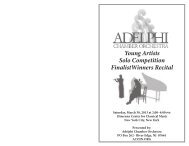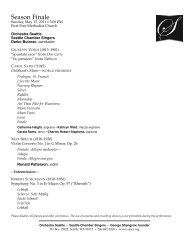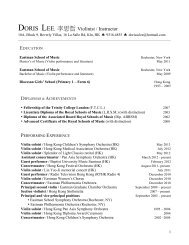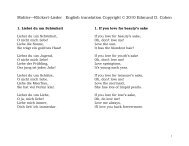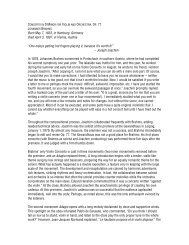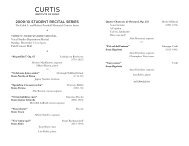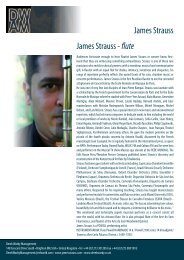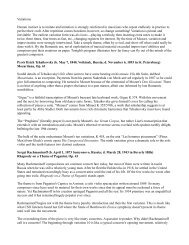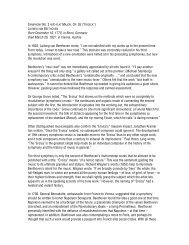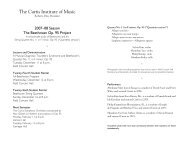Coriolan Overture, opus 62 Ludwig van Beethoven ... - InstantEncore
Coriolan Overture, opus 62 Ludwig van Beethoven ... - InstantEncore
Coriolan Overture, opus 62 Ludwig van Beethoven ... - InstantEncore
You also want an ePaper? Increase the reach of your titles
YUMPU automatically turns print PDFs into web optimized ePapers that Google loves.
concert life. Interestingly, his friend and fellow striver then was Georges Bizet; the two<br />
young composers cheered each other on, and Bizet even made a piano transcription of the<br />
Introduction and Rondo to sell to non-virtuosos playing at home.<br />
The extraordinary young Spanish violinist Pablo de Sarasate was another friend<br />
of Saint-Saëns, and his special qualities as a virtuoso shaped the way the composer would<br />
write for this instrument. Sarasate’s tone was not large, but it was pure and brilliant, and<br />
his intonation was unerring. None other than George Bernard Shaw (a music critic in his<br />
early career) described him bluntly: “He never interprets anything: he plays it beautifully,<br />
and that is all. He is always alert, swift, clear, refined, certain, scrupulously attentive, and<br />
quite unaffected.”<br />
Therefore, in composing the Introduction and Rondo for him, Saint-Saëns<br />
emphasized clarity of sound and de-emphasized the orchestral part to allow the violinist’s<br />
smallish tone to dominate. He also concocted melodies and rhythms with a slightly<br />
Spanish flavor to salute the violinist’s homeland. Years later as their friendship<br />
continued, Saint-Saëns created a full-length concerto for the Spaniard: the sumptuously<br />
beautiful Third Violin Concerto.<br />
Not initially a success with French audiences, the Introduction and Rondo has<br />
now become one of the most beloved of all virtuoso violin showpieces. Scholar Michael<br />
Stegemann suggests that it is actually an instrumental adaptation of the standard formula<br />
for a French operatic aria in the middle 19 th century: a slow-tempo arioso or recitative<br />
followed by a fast brilliant aria. In a slow introductory section, the violinist unfurls a<br />
soulful melody in A minor. Then the music snaps into a lively Allegro for the rondo<br />
itself. Linked together by the puckish rondo theme that the soloist introduces at the<br />
beginning, it boasts a variety of infectiously tuneful episodes, some suggesting Spanish<br />
dance, others exploiting the violin’s capacity for tender, heart-on-sleeve singing. The<br />
faster closing coda finally carries the music into the brighter key of A major.<br />
Zigeunerweisen (Gypsy Airs)<br />
Pablo de Sarasate<br />
(b. 1844, Pamplona, Spain; d. 1908, Biarritz, France)<br />
The legendary Spanish violin virtuoso Pable de Sarasate composed Zigeunerweisen, one<br />
of the most popular of all violin showpieces, to display his own unsurpassed mastery of<br />
the instrument. His prodigious talent revealed itself early, and at age 12, he was sent to<br />
Paris, with the assistance of Spain's Queen Isabella, to study at the Conservatoire. He<br />
became renowned for the elegance of his playing and the beauty of his tone. Violinist<br />
Leopold Auer described it as “a tone of supreme singing quality,” while the conductor<br />
Hans von Bülow remembered his “seductive speaking on the violin.” His intonation was<br />
considered perfect, and his ease in all registers of the violin — but especially in its<br />
hazardous upper reaches — miraculous.<br />
Not content with being a traveling virtuoso, Sarasate also turned his hand to<br />
composing. Today he is best known for his Carmen Fantasy, based on themes from<br />
Bizet's opera, and for Zigeunerweisen or "Gypsy Airs" (1878). Unlike the Carmen<br />
Fantasy, there is nothing Spanish about the gypsy music evoked in Zigeunerweisen;<br />
rather, as its German title suggests, it celebrates the gypsy-violin tradition of Eastern<br />
Europe, in the manner of Liszt's and Brahms Hungarian rhapsodies.



